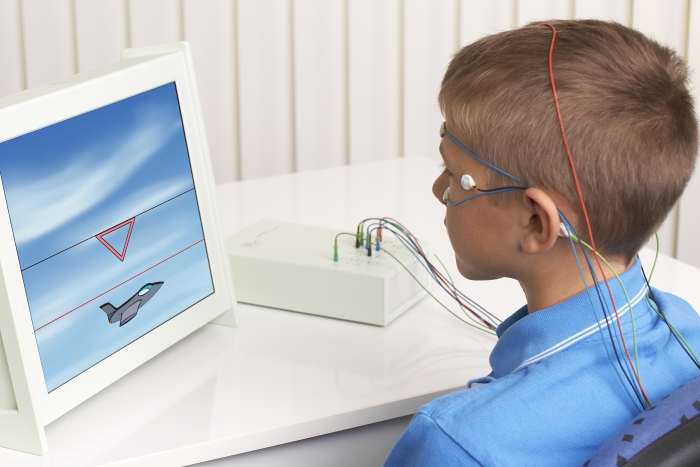Interoceptive awareness and emotion regulation
Monitoring our body and the signals that our body sends us can provide a lot of valuable information about our physical wellbeing, but also about our mental wellbeing. This is because our physiology (body) and our mind (psychology) are closely linked1-2 as was highlighted in our previous blog.
The ability to sense and interpret these internal signals is referred to as interoceptive awareness, which plays an important role in our ability to regulate emotions.3 Specifically, carefully observing (changes in) the way we feel and how our body responds to certain situations, can help us figure out how we can make changes that make us feel better or make it easier to cope with challenging situations.4-7
Biofeedback training
Biofeedback is the process of measuring an individual’s physiological activity and providing individuals with real-time feedback about this activity. By providing this feedback people can gain more insight into their internal state and they can learn how to change their physiological activity in an adaptive manner.8 The way this physiological activity is communicated can vary from displaying raw physiological signals (e.g. ECG; heart rate or EEG; brain waves) to using graphs and interactive animations.9-10 In biofeedback training, people practice self-regulation by trying to keep their physiological activity above or below a certain threshold, with positive changes in activity being rewarded. E.g. in the picture below, an animation of a plane responds to a person’s brain activity and the aim is to try and keep the plane above/below a certain line.

Biofeedback video games
In recent years a number of video games have been developed that react to how a player feels, which is derived from their physiological activity (e.g. heart rate, brain activity or breath). Within the GEMH-lab there are a number of projects that explore the potential of using biofeedback video games as an intuitive and engaging way to help youth effectively regulate their emotions. Here you can find a list of these games and the related research projects.
Mindlight

Mindlight - Childhood Anxiety Prevention
MindLight - Children with an Autism Spectrum Disorder
Mindlight - Associations between gameplay and improvements
DEEP

Biofeedback Games for Anxiety Regulation
Nevermind

Nevermind - Biofeedback Games for Emotion Regulation
Gaming and Psycho-social Development
DUST

Control over Automatic Tendencies under Threat
Dojo

-----
Sources:
- Damasio, A. R. (1996). The somatic marker hypothesis and the possible functions of the prefrontal cortex. Phil. Trans. R. Soc. Lond. B, 351(1346), 1413-1420.
- Niedenthal, P. M. (2007). Embodying emotion. science, 316(5827), 1002-1005.
- Gross, J. J. (2002). Emotion regulation: Affective, cognitive, and social consequences. Psychophysiology, 39(3), 281-291.
- Füstös, J., Gramann, K., Herbert, B. M., & Pollatos, O. (2012). On the embodiment of emotion regulation: interoceptive awareness facilitates reappraisal. Social cognitive and affective neuroscience, 8(8), 911-917.
- Kanbara, K., & Fukunaga, M. (2016). Links among emotional awareness, somatic awareness and autonomic homeostatic processing. BioPsychoSocial medicine, 10(1), 16.
- Kever, A., Pollatos, O., Vermeulen, N., & Grynberg, D. (2015). Interoceptive sensitivity facilitates both antecedent-and response-focused emotion regulation strategies. Personality and Individual Differences, 87, 20-23.
- Wiens, S. (2005). Interoception in emotional experience. Current opinion in neurology, 18(4), 442-447.
- Gilbert, C., & Moss, D. (2003). Biofeedback and biological monitoring. Handbook of mind-body medicine in primary care: Behavioral and physiological tools, 109-122.
- Lehrer, P. M., Vaschillo, E., & Vaschillo, B. (2000). Resonant frequency biofeedback training to increase cardiac variability: Rationale and manual for training. Applied psychophysiology and biofeedback, 25(3), 177-191.
- Peper, E., Harvey, R., & Takebayashi, N. (2009). Biofeedback an evidence based approach in clinical practice. Japanese Journal of Biofeedback Research, 36(1), 3-10.
- https://focushereandnow.com/biofeedback-therapy-training/ (picture neurofeedback)
- https://virtualrealitypop.com/brainwaves-and-vr-a-weekend-at-microsoft-reactor-8ec8e40b177a (biofeedback VR image overview)






